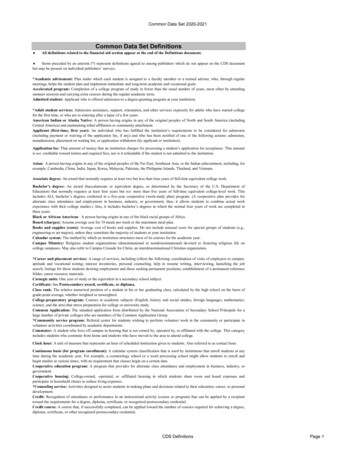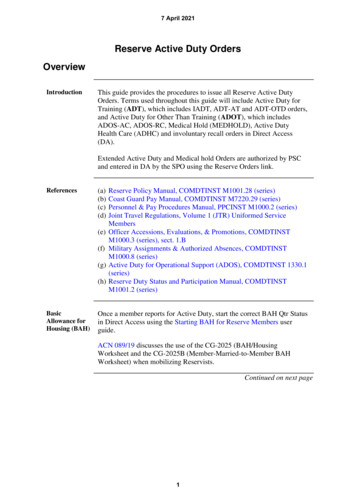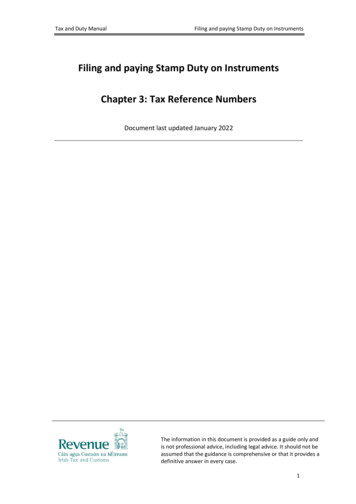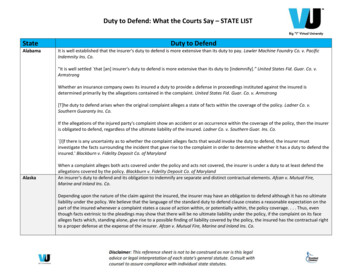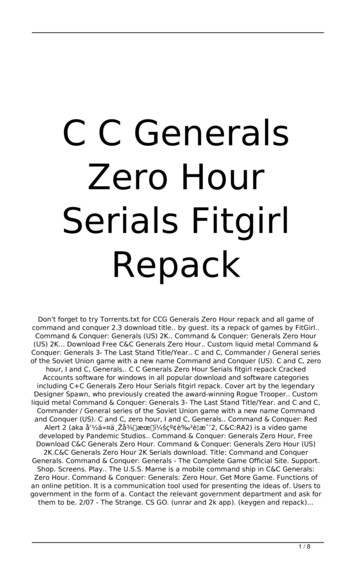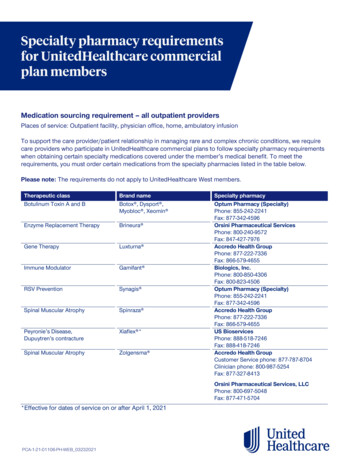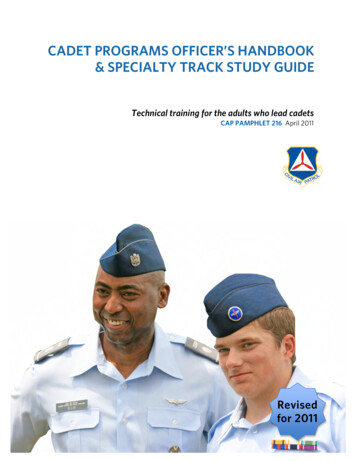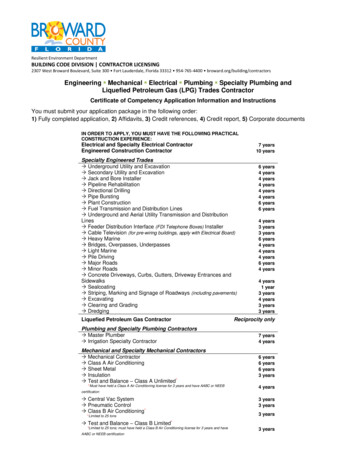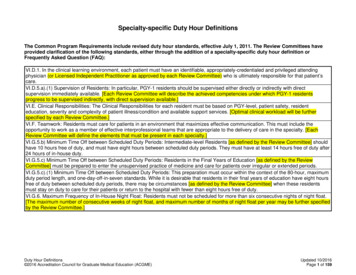
Transcription
Specialty-specific Duty Hour DefinitionsThe Common Program Requirements include revised duty hour standards, effective July 1, 2011. The Review Committees haveprovided clarification of the following standards, either through the addition of a specialty-specific duty hour definition orFrequently Asked Question (FAQ):VI.D.1. In the clinical learning environment, each patient must have an identifiable, appropriately-credentialed and privileged attendingphysician (or Licensed Independent Practitioner as approved by each Review Committee) who is ultimately responsible for that patient’scare.VI.D.5.a).(1) Supervision of Residents: In particular, PGY-1 residents should be supervised either directly or indirectly with directsupervision immediately available. [Each Review Committee will describe the achieved competencies under which PGY-1 residentsprogress to be supervised indirectly, with direct supervision available.]VI.E. Clinical Responsibilities: The Clinical Responsibilities for each resident must be based on PGY-level, patient safety, residenteducation, severity and complexity of patient illness/condition and available support services. [Optimal clinical workload will be furtherspecified by each Review Committee.]VI.F. Teamwork: Residents must care for patients in an environment that maximizes effective communication. This must include theopportunity to work as a member of effective interprofessional teams that are appropriate to the delivery of care in the specialty. [EachReview Committee will define the elements that must be present in each specialty.]VI.G.5.b) Minimum Time Off between Scheduled Duty Periods: Intermediate-level Residents [as defined by the Review Committee] shouldhave 10 hours free of duty, and must have eight hours between scheduled duty periods. They must have at least 14 hours free of duty after24 hours of in-house duty.VI.G.5.c) Minimum Time Off between Scheduled Duty Periods: Residents in the Final Years of Education [as defined by the ReviewCommittee] must be prepared to enter the unsupervised practice of medicine and care for patients over irregular or extended periods.VI.G.5.c).(1) Minimum Time Off between Scheduled Duty Periods: This preparation must occur within the context of the 80-hour, maximumduty period length, and one-day-off-in-seven standards. While it is desirable that residents in their final years of education have eight hoursfree of duty between scheduled duty periods, there may be circumstances [as defined by the Review Committee] when these residentsmust stay on duty to care for their patients or return to the hospital with fewer than eight hours free of duty.VI.G.6. Maximum Frequency of In-House Night Float: Residents must not be scheduled for more than six consecutive nights of night float.[The maximum number of consecutive weeks of night float, and maximum number of months of night float per year may be further specifiedby the Review Committee.]Duty Hour Definitions 2016 Accreditation Council for Graduate Medical Education (ACGME)Updated 10/2016Page 1 of 159
Allergy and Immunology . 5Anesthesiology . 6Anesthesiology – Adult Cardiothoracic . 8Anesthesiology – Critical Care Medicine. 9Anesthesiology – Obstetric. 10Anesthesiology – Pediatric . 11Anesthesiology – Regional Anesthesiology and Acute Pain Medicine . 13Colon and Rectal Surgery . 13Dermatology . 14Dermatology – Micrographic Surgery and Dermatologic Oncology . 15Diagnostic Radiology . 15Diagnostic Radiology – Abdominal . 16Diagnostic Radiology – Musculoskeletal . 17Diagnostic Radiology – Neuroradiology . 18Diagnostic Radiology – Nuclear . 19Diagnostic Radiology – Pediatric . 20Diagnostic Radiology – Vascular and Interventional . 21Family Medicine . 23Internal Medicine . 25Internal Medicine – Adult Congenital Heart Disease . 29Internal Medicine – Advanced Heart Failure and Transplant Cardiology . 31Internal Medicine – Cardiovascular Disease . 34Internal Medicine – Clinical Cardiac Electrophysiology . 36Internal Medicine – Critical Care Medicine. 37Internal Medicine – Endocrinology, Diabetes, and Metabolism . 40Internal Medicine – Gastroenterology . 42Internal Medicine – Hematology . 45Internal Medicine – Hematology and Medical Oncology . 47Internal Medicine – Infectious Disease . 50Internal Medicine – Interventional Cardiology . 53Internal Medicine – Medical Oncology . 54Internal Medicine – Nephrology . 57Internal Medicine – Pulmonary Critical Care . 60Internal Medicine – Pulmonary Disease. 62Internal Medicine – Rheumatology. 65Internal Medicine – Transplant Hepatology. 67Interventional Radiology . 69Medical Genetics and Genomics . 69Medical Genetics and Genomics – Medical Biochemical Genetics . 70Neurological Surgery . 71Neurology . 75Neurology – Child . 77Neurology – Clinical Neurophysiology . 78Duty Hour Definitions 2016 Accreditation Council for Graduate Medical Education (ACGME)Updated 10/2016Page 2 of 159
Neurology – Epilepsy . 78Neurology – Neurodevelopment Disabilities . 79Neurology – Vascular . 80Nuclear Medicine . 81Obstetrics and Gynecology . 82Obstetrics and Gynecology – Gynecologic Oncology . 82Obstetrics and Gynecology – Maternal-Fetal Medicine . 83Obstetrics and Gynecology – Reproductive Endocrinology and Infertility . 83Ophthalmology . 84Ophthalmology – Ophthalmic Plastic and Reconstructive Surgery . 86Orthopaedic Surgery . 87Orthopaedic Surgery Subspecialties . 90Osteopathic Neuromusculoskeletal Medicine . 90Otolaryngology . 91Otolaryngology – Neurotology . 94Otolaryngology – Pediatric . 96Pathology . 97Pathology – Blood Banking/Transfusion Medicine . 99Pathology – Chemical . 100Pathology – Cytopathology . 100Pathology – Forensic . 101Pathology – Hematopathology . 102Pathology – Medical Microbiology. 103Pathology – Neuropathology . 103Pathology – Pediatric . 104Pathology – Selective . 105Pediatrics . 105Pediatrics Subspecialties . 107Physical Medicine and Rehabilitation . 109Physical Medicine and Rehabilitation – Spinal Cord Injury Medicine . 110Physical Medicine and Rehabilitation – Pediatric Rehabilitation Medicine . 111Plastic Surgery. 112Plastic Surgery – Craniofacial Surgery . 115Preventive Medicine . 118Psychiatry . 119Psychiatry – Addiction . 121Psychiatry – Child and Adolescent . 122Psychiatry – Forensic . 122Psychiatry – Geriatric . 123Psychiatry – Psychosomatic Medicine . 124Radiation Oncology . 125Surgery . 126Surgery – Complex General Surgical Oncology . 131Duty Hour Definitions 2016 Accreditation Council for Graduate Medical Education (ACGME)Updated 10/2016Page 3 of 159
Surgery – Pediatric . 132Surgery – Surgical Critical Care . 135Surgery – Vascular . 137Thoracic Surgery . 140Thoracic Surgery – Congenital Cardiac Surgery . 143Transitional Year. 144Urology . 145Urology – Pediatric . 146MULTIDISCIPLINARY SUBSPECIALTIES . 146Clinical Informatics (subspecialty of Anesthesiology, Diagnostic Radiology, Emergency Medicine, Family Medicine, Internal Medicine, Medical Genetics,Pathology, Pediatrics, or Preventive Medicine) . 146Dermatopathology (subspecialty of Dermatology or Pathology) . 147Endovascular Surgical Neuroradiology (subspecialty of Diagnostic Radiology, Neurological Surgery, or Neurology) . 148Female Pelvic Medicine and Reconstructive Surgery (subspecialty of Obstetrics and Gynecology or Urology0 . 149Geriatric Medicine (subspecialty of Family Medicine or Internal Medicine) . 150Hand Surgery (subspecialty of General Surgery, Orthopaedic Surgery, or Plastic Surgery) . 151Hospice and Palliative Medicine (subspecialty of Anesthesiology, Family Medicine, Internal Medicine, Pediatrics, Psychiatry, or Radiation Oncology) 152Medical Toxicology (subspecialty of Emergency Medicine or Preventive Medicine) . 153Molecular Genetic Pathology (subspecialty of Medical Genetics and Genomics or Pathology) . 154Neuromuscular Medicine (subspecialty of Neurology or Physical Medicine and Rehabilitation) . 155Pain Medicine (subspecialty of Anesthesiology, Neurology, or Physical Medicine and Rehabilitation) . 156Sleep Medicine (subspecialty of Internal Medicine, Neurology, Pediatrics, or Psychiatry) . 156Sports Medicine (subspecialty of Emergency Medicine, Family Medicine, Pediatrics, or Physical Medicine and Rehabilitation) . 158Undersea and Hyperbaric Medicine (subspecialty of Emergency Medicine or Preventive Medicine) . 159Duty Hour Definitions 2016 Accreditation Council for Graduate Medical Education (ACGME)Updated 10/2016Page 4 of 159
Specialty/Requirement # Specialty-specific Duty Hour DefinitionsAllergy and ImmunologyVI.D.1. LicensedIndependent PractitionerVI.D.5.a).(1) Supervisionof ResidentsVI.E. ClinicalResponsibilitiesQ: Which licensed independent practitioners are acceptable to providesupervision to residents?A: Clinical psychologists, clinical social workers, nurse practitioners, physicianassistants, and registered dieticians, for example, may supervise residents'clinical activities when the program director determines that their specialexpertise will promote education and provide a level of supervision equivalent tothat provided by an attending physician. During these situations, there mustalso be direct or indirect, as required, supervision by a physician facultymember.Do not have PGY-1 residents in the specialty.VI.F. TeamworkVI.G.5.b) Intermediatelevel ResidentsFrequently Asked Questions (FAQs)No residents will be designated as being at the intermediatelevel.Q: What is the optimal clinical workload for an allergy and immunologyresident?A: A resident’s clinical workload should provide sufficient opportunities to meetall of the program requirements for patient care experiences. Using Case Logdata as a reference standard, residents should see an adequate number ofpatients to reach required diagnoses for at least the tenth percentile of patients.Programs should ensure that patients are evenly distributed across the timededicated for clinical activity during the residency. Residents’ logs should bemonitored during all formal performance evaluation sessions.Q: Which other health care professionals should be a part of the residents'interprofessional team?A: Advanced practice providers, audiologists, billing and administrative staffmembers, nurses, nutritional consultants, pharmacists, physician assistants,respiratory therapists, social workers, and speech and language pathologistsmay be included as a part of interprofessional teams.Residents must demonstrate the ability to work and to communicate withhealth care professionals to provide effective, patient-focused care.Q: Is a first year allergy and immunology resident considered to be a PGY-1 orintermediate level resident?A: Program directors should monitor resident duty hour requirements in amanner consistent with the year of post-graduate education each resident hasachieved. The majority of allergy and immunology residents enter specialtyeducation at the PGY-4 or PGY-5 level. From a duty hour perspective, first yearallergy and immunology residents should be able to function as advancedresidents consistent with program requirement VI.G.5.c). However, some maycome to residency with a specialized education schedule, and may only be atthe PGY-2 or PGY-3 level. These residents should be monitored as“intermediate” residents for one year. Regardless of level of education, allresidents must hav
VI.G.5.b) Minimum Time Off between Scheduled Duty Periods: Intermediate-level Residents [as defined by the Review Committee] should have 10 hours free of duty, and must have eight hours between scheduled duty periods. They must have at least 14 hours free of duty after 24 hours of in-house duty.

